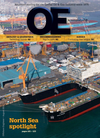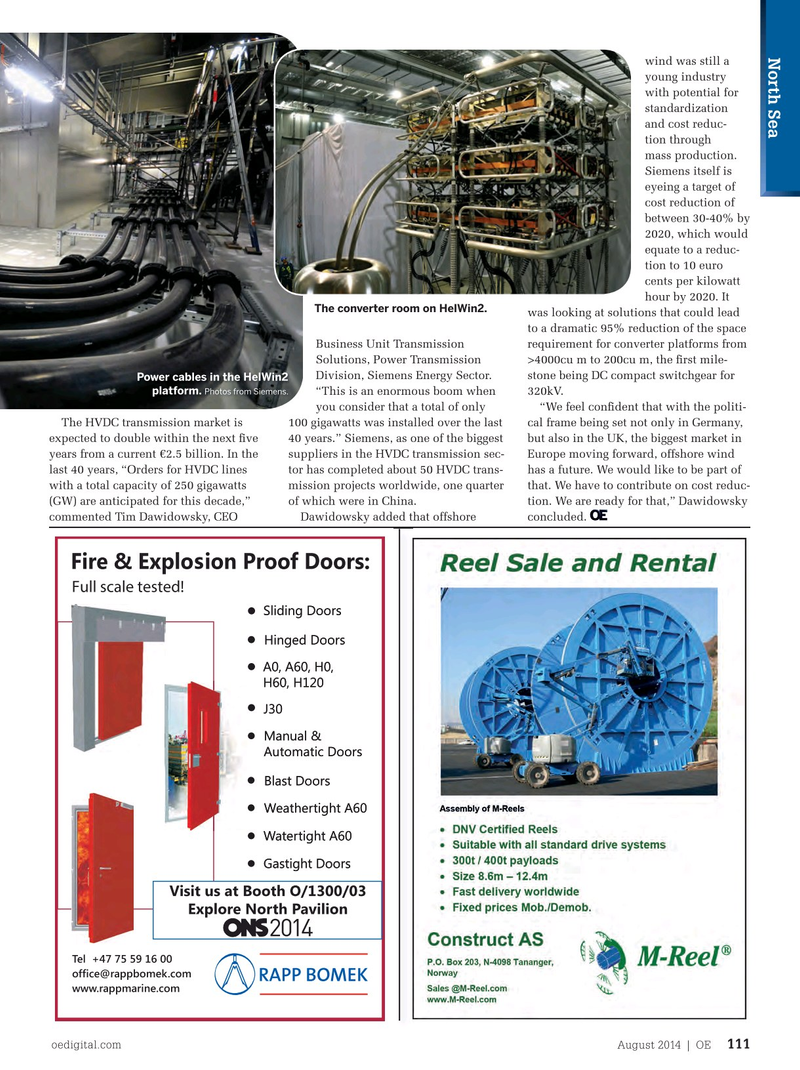
Page 109: of Offshore Engineer Magazine (Aug/Sep 2014)
Read this page in Pdf, Flash or Html5 edition of Aug/Sep 2014 Offshore Engineer Magazine
North Sea wind was still a young industry with potential for standardization and cost reduc- tion through mass production.
Siemens itself is eyeing a target of cost reduction of between 30-40% by 2020, which would equate to a reduc- tion to 10 euro cents per kilowatt hour by 2020. It
The converter room on HelWin2. was looking at solutions that could lead to a dramatic 95% reduction of the space
Business Unit Transmission requirement for converter platforms from
Solutions, Power Transmission >4000cu m to 200cu m, the ? rst mile-
Division, Siemens Energy Sector. stone being DC compact switchgear for
Power cables in the HelWin2 platform. Photos from Siemens.
“This is an enormous boom when 320kV. you consider that a total of only “We feel con? dent that with the politi-
TenneT is also tying in DolWin1, 2, 3 The HVDC transmission market is 100 gigawatts was installed over the last cal frame being set not only in Germany, cluster, 165km off Dollard Bay. DolWin1 expected to double within the next ? ve 40 years.” Siemens, as one of the biggest but also in the UK, the biggest market in was also built by HFG, for client ABB, years from a current €2.5 billion. In the suppliers in the HVDC transmission sec- Europe moving forward, offshore wind with Heerema Zwijndrecht supplying last 40 years, “Orders for HVDC lines tor has completed about 50 HVDC trans- has a future. We would like to be part of the topsides, and Heerema Vlissingen the with a total capacity of 250 gigawatts mission projects worldwide, one quarter that. We have to contribute on cost reduc- jacket. Commissioning is ongoing. The (GW) are anticipated for this decade,” of which were in China. tion. We are ready for that,” Dawidowsky
DolWin2 platform was built in Dubai. commented Tim Dawidowsky, CEO Dawidowsky added that offshore concluded.
The sailaway was June 10. The projected wind farms in the DolWin cluster are:
Borkum Riffgrund1, Borkum Riffgrund2,
Gode Wind1, Gode Wind2, MEG
Full scale tested!
Offshore1, Nordsee One, and Trianel
Windpark Borkum.
The converter technology used by
Siemens is called HVDC Plus. This is a voltage-sourced converter of the modular multi-level converter type. By contract with the conventional HVDC version, which can only be used in networks with suf? cient short-circuit capacity, systems using HVDC Plus make it possible to start up island networks from scratch, an important prerequisite for operation offshore.
HVDC technology enables the alternat- ing current generated by the wind farms to be converted to low loss direct current.
Siemens says transmission losses per link are less than 3%, not including cable losses. First a number of transformer
Visit us at Booth O/1300/03
Celebtating , 5-8 May OTC-2014 platforms arranged around the wind farm transform the alternating current before
Explore North Pavilion
Booth 5041,
Houston, ou at it is converted into direct current on an
Nor
HVDC platform. It is transported to land via a submarine cable and then con- verted back into alternating current for onward transmission. HVDC technology is usually used when transmission cable lengths reach 80km or longer.
oedigital.com August 2014 | OE 111 110_OE0814_Geofocus3_Meg.indd 111 7/23/14 1:10 AM

 108
108

 110
110